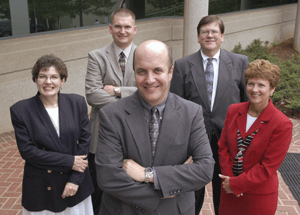Collaborative efforts

Nearly three years after the Sept. 11 terrorist attacks, federal, state and local agencies are still deciding how best to collaborate and share vital information. The good news: emerging cooperative efforts such as the one engineered by this team from Science Applications International Corp., which negotiated the sharing of health data.
Following last year's SARS outbreak, the Centers for Disease Control and Prevention asked state and local governments for the names of everyone collecting data on the disease throughout the United States. State and local officials, citing privacy concerns, balked at the request. Rather than turn the issue into a bureaucratic turf battle, CDC turned to Science Applications International Corp. to break the impasse.As a liaison between CDC and state and local governments, SAIC brokered a compromise in which the state and local jurisdictions gave CDC the names of those in charge of the health departments that were collecting information about Severe Acute Respiratory Syndrome. If CDC needed to review the data of a particular region, it would go through the proper channels to get it. "The states' privacy was protected, and the federal government got its information," said Don Nestor, project manager for the Public Health Information Network Certification Group with San Diego-based SAIC. Nearly three years after the Sept. 11 terrorist attacks, federal, state and local agencies are still deciding how best to collaborate and share vital information. Before the attacks, federal agencies often dictated standards and solutions to state and local governments, but that changed with the advent of homeland security. Like CDC, other federal agencies now are more willing to consult with state and local officials as stakeholders in planning IT initiatives. Despite increased outreach by federal officials, intergovernmental collaboration remains weak in areas directly related to homeland security, such as public health management, interoperable communications for first responders and counter-terrorism intelligence, according to analysts and industry experts."What passes as good examples of collaboration is largely because, in the past, no one was paying attention and the performance bar was set so low," said Tom Davies, senior vice president with Current Analysis Inc., Sterling, Va.State and local officials appreciate almost any sincere federal effort that increases their interaction and collaboration on IT with the federal government. Matt Miszewski, Wisconsin's chief information officer, stressed the importance of aligning state and local initiatives with federal initiatives."It's easier to work in alignment with the federal government than in opposition," he said. For criminal justice and homeland security, "there is both federal funding and passion," he said. Michael Armstrong, chief information officer of Des Moines, Iowa, said he understands the enormous task the federal government faces in reaching out to 50 states and 19,000 local governments. The federal government may have a long road ahead of it, but it deserves credit for making the effort, he said."There's been a lot of discussion since Sept. 11 about the need for cooperation," Armstrong said. "We still have a long way to go, but at least we're talking." Large-scale collaborationJust as CDC turned to SAIC to help it work effectively with state and local health organizations, the Justice Department is relying on more than 30 national organizations to help it create data-sharing networks among criminal justice agencies at all levels of government. Among the organizations are the Integrated Justice Information Sharing Institute, the National Governors Association and the National Consortium for Justice Information and Statistics, known as Search. The Justice Department is using the Pennsylvania Justice Network, or JNET, as a model for other state and local governments. JNET provides a real-time link among the FBI, state agencies with criminal justice responsibilities and various cities and counties throughout Pennsylvania. For example, police in Delaware County, Pa., caught a man who robbed a bank there by matching an image of him captured on security videotape to an image stored on JNET. Once the police identified the suspect, they located and arrested him in less than two hours.A few years ago, states couldn't afford systems to share criminal justice information, but they are making dramatic strides toward justice information sharing despite financially troubled times, said Pat McCreary, senior policy adviser with the Justice Department's Bureau of Justice Assistance Policy office."Since the advent of Sept. 11, people's interest in this field has really exploded," he said.The Bureau of Justice Assistance has provided about $20 million annually in discretionary funds to state and local governments in the last few years to help them plan and implement systems that support justice information sharing, McCreary said.Justice Department officials have identified information sharing "as an area that will get favorable funding," said Bob Hickes, director of homeland security for state and local government at BearingPoint Inc., McLean, Va. BearingPoint was the prime contractor on JNET.Although Justice officials encourage states to build systems such as JNET, the department is letting each state and local jurisdiction proceed with its own strategy, Hickes said. The department has tapped national industry and government organizations to help state and local governments find the right solution. One of Justice's high-profile partners for the effort is the National Governors Association of Washington. The Bureau of Justice Assistance provides funding and grant administration, while NGA's Center for Best Practices gives technical support and monitoring assistance. Through this arrangement, 42 states have received planning-grant funding, and 26 have received funding to assist with implementation, McCreary said. These projects range from electronic data sharing among states and counties to jail management systems and strategic planning for justice information sharing. "We did this without a huge dollar investment," McCreary said, referring to the seed money the Justice Department provided to states for justice information sharing projects. XXXSPLITXXX-Alabama Department of Public HealthProject: Bioterrorism Data WarehouseTerm: To be decidedValue: To be decidedStatus: Pre-request for proposalSummary: The agency plans to operate a Bioterrorism Data Warehouse. It will use adopted data warehouse architecture developed by the state's Information Services Division Alaska Health and Social Services DepartmentProject: Web Laboratory Information Management SystemTerm: To be decidedValue: $600,000Status: Pre-RFPSummary: The Alaska State Public Health Laboratory may re-solicit proposals for technical assistance in planning, developing, implementing and supporting a Web information management system to give the state a flexible, comprehensive, integrated database system that addresses the workflow and communication needs of the public health laboratory. Baltimore Metropolitan CouncilProject: Crisis Management SoftwareTerm: To be decidedValue: $450,000Status: Pre-RFPSummary: The council wants a crisis management software solution that will optimize emergency management activities within the Baltimore region. Centers for Disease Control and PreventionProject: Public Health Information NetworkTerm: To be decidedValue: To be decidedStatus: Pre-RFPSummary: CDC wants to build a public health information network that will detect problems, analyze accumulated data, create useful information, communicate alerts and direct responses to maintain health. Justice DepartmentProject: Emergency Provider Access Directory Communication SystemTerm: To be decidedValue: $20 millionStatus: Request for proposal scheduled for July 12 Summary: The Communications for Coordinated Assistance and Response to Emergencies Alliance wants to link emergency agencies through a Web services communications system, a shared, national and nonprofit directory of agencies. Nevada Information Technology DepartmentProject: Interoperability Assessment Study and Emergency Communication Plan UpdateTerm: To be decidedValue: $150,000Status: Pre-RFPSummary: The agency wants a vendor to conduct an interoperability assessment study and emergency communication plan update for the Department of Emergency Management. New Hampshire Department of Health and Human ServicesProject: Automated Hospital Emergency Department Data ProjectTerm: To be decidedValue: To be decidedStatus: Proposals due by July 19Summary: The agency wants a vendor to build an electronic data transmission system from selected New Hampshire hospitals to the state Community and Public Health Office. The project includes building unique identifiers, constructing a data repository and establishing syndromic surveillance analysis and alert tools.South Carolina Public Safety DepartmentProject: Criminal Justice IntegrationTerm: To be decidedValue: To be decidedStatus: Pre-RFPSummary: The agency may release a solicitation to procure technology to integrate criminal justice information. Source: Federal Sources Inc.XXXSPLITXXX-For federal, state and local governments that want to work well together, government and industry experts offer the following advice:-- Adopt a federated approach to leadership. A federation or board consisting of all participating agencies is preferred to having a single agency oversee an intergovernmental project. -- Get stakeholder input. The board or agency overseeing the project should involve stakeholders in establishing requirements, and then maintain stakeholder involvement throughout the project. -- Find strong executive sponsorship. The projects that succeed tend to have strong executive sponsorship from a governor, cabinet head or key department or agency head. -- Encourage financial investment. Projects in which participants have committed some of their own funds have a greater chance of success than those that are funded entirely with federal dollars. -- Avoid multiple agendas. Participants should share similar or identical goals and refrain from setting goals that vary or differ from the main objective of the project. -- Align federal, state and local objectives. Make sure the federal goals and objectives accommodate the needs of the state and local stakeholders. -- Establish standards and architecture requirements. State and local governments need guidance on standards and architecture from federal agencies so that they can make technology investments that are compatible with federal systems. -- Build incentives and disincentives into the project. Creating incentives and disincentives around funding will help ensure the project participants cooperate and keep their eye on shared goals and objectives. -- Assign each agency one vote. Give each participating agency only one vote as a way to promote fairness and create a level playing field. -- Require regular attendance. The participants should send the same representatives on a regular basis to each meeting and avoid turnover as much as possible to maintain a consistent membership.



CDC's Dr. John Loonsk, center, is working more closely with state and local governments -- thanks to help from SAIC's Jackalie Blue, Joseph Baweja, Don Nestor and Barbara Wasely.

"What passes as good examples of collaboration is largely because, in the past, no one was paying attention and the performance bar was set so low,"
Tom Davies, senior vice president, Current Analysis Inc., Sterling, Va.
NEXT STORY: For Accenture, winning is just the beginning

